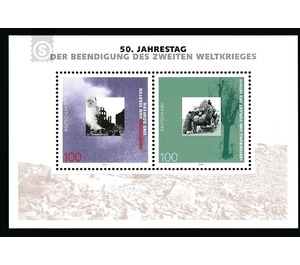Block edition: 50th anniversary of the end of World War II - Germany / Federal Republic of Germany 1995
Theme: Calender
| Country | Germany / Federal Republic of Germany |
| Issue Date | 1995 |
| Item Type | Block |
| Chronological Chapter | GER-BRD |
| Chronological Issue Number | Block 31 |
| SID | 226082 |
| In 29 Wishlists | |
Escape and displacement to the greatest degree characterize the 20th century. From 1926 to 1939, more than 3 million members of various peoples from European parts of the Soviet Union were forcibly relocated to Siberia or the Far East in the USSR. From 1933 to 1939 more than 350,000 Jewish people fled Germany from the persecution of the Nazi regime. 1 million Poles and about 300,000 Jews were deported to the "Generalgouvernement" after the incorporation of the Polish western territories into the German Reich in 1939/40. After the beginning of the German invasion of the Soviet Union, Stalin sent about 400,000 Volga Germans and 150,000 Germans residing in Volhynia to Central Asia. At the beginning of 1945, one of the largest refugee movements of the post-war history began with the refugee stretches from the German eastern territories, which reached another climax with the expulsion of the Germans from Poland, Czechoslovakia and Hungary after the end of the war. About 16.5 million people were affected by this resettlement action, which the Western powers attempted to humanize in the Potsdam Agreement. 2.5 million did not survive the hardships of the escape. The inclusion of these masses of people in a country largely destroyed by the war, in which a catastrophic supply situation prevailed, brought additional and almost unsolvable problems for the military governments and the German administrative offices.


